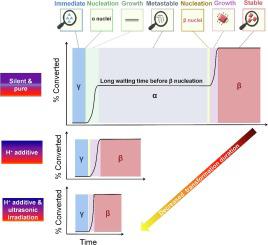当前位置:
X-MOL 学术
›
Ultrason. Sonochem.
›
论文详情
Our official English website, www.x-mol.net, welcomes your feedback! (Note: you will need to create a separate account there.)
Facilitating polymorphic crystallization of HMX through ultrasound and trace additive assistance
Ultrasonics Sonochemistry ( IF 8.7 ) Pub Date : 2024-06-06 , DOI: 10.1016/j.ultsonch.2024.106946 Jie Li , Shichun Li , Shiliang Huang , Jinjiang Xu , Qilong Yan , Shaohua Jin , Yu Liu
Ultrasonics Sonochemistry ( IF 8.7 ) Pub Date : 2024-06-06 , DOI: 10.1016/j.ultsonch.2024.106946 Jie Li , Shichun Li , Shiliang Huang , Jinjiang Xu , Qilong Yan , Shaohua Jin , Yu Liu

|
Low sensitivity octahydro-1,3,4,7-tetranitro-1,3,5,7-tetrazocine (HMX) has garnered significant attention from researchers due to its reduced shock sensitivity. However, the crystallization process poses challenges due to the high solidity and viscosity of the metastable α phase. Despite efforts to address this with additional energy sources like ultrasonic irradiation, prolonged exposure duration often results in small particle sizes, hindering the production of HMX with a consistent particle size distribution, thus limiting its applicability. To overcome these challenges, a method combining ultrasonic irradiation and trace H additive was proposed and investigated for their impact on the polymorphic transformation of HMX. The H additive was found to modify barriers, thus there was a lack of competitive driving force for the nucleation or growth of the metastable α form, thereby shortening the transformation pathway and duration. Moreover, the H additive significantly accelerated the nucleation rate of the β form (67.7 orders of magnitude faster with 0.10 wt ‰ H) and the growth rate of β form HMX (5.8 orders of magnitude faster with 0.10 wt ‰ H). While H additive alone was insufficient to induce spontaneous nucleation of the β form, combining it with short-duration ultrasonic irradiation further promoted β nucleation and shortened the polymorphic transformation duration (almost 20 orders of magnitude shorter). This rational approach led to effective control of the transformation process. The resulting low sensitivity HMX crystals exhibited varying mean sizes ranging from 20 to 340 μm, with purity exceeding 99.6 %, an apparent density greater than 1.8994 g/cm, and few internal defects, fully meeting the requirements of low-sensitivity HMX, thus significantly expanding its potential applications. Our study sheds light on the mechanisms governing HMX polymorphic transformation in the presence of additives and ultrasonic irradiation, offering guidance for the rational control of this complex transformation.
中文翻译:

通过超声波和微量添加剂辅助促进 HMX 多晶型结晶
低敏感性八氢-1,3,4,7-四硝基-1,3,5,7-四佐辛(HMX)由于其降低的冲击敏感性而引起了研究人员的极大关注。然而,由于亚稳α相的高硬度和高粘度,结晶过程面临挑战。尽管努力通过超声波辐射等额外能源来解决这个问题,但长时间的暴露通常会导致粒径变小,从而阻碍了具有一致粒径分布的 HMX 的生产,从而限制了其适用性。为了克服这些挑战,提出了一种结合超声波照射和微量H添加剂的方法,并研究了它们对HMX多晶型转化的影响。研究发现H添加剂可以改变势垒,因此亚稳态α形式的成核或生长缺乏竞争驱动力,从而缩短了转化途径和持续时间。此外,H添加剂显着加速了β晶型的成核速率(0.10wt%H时提高了67.7个数量级)和β晶型HMX的生长速率(0.10wt%H时提高了5.8个数量级)。虽然单独的H添加剂不足以诱导β晶型的自发成核,但将其与短时超声波辐射相结合进一步促进了β成核并缩短了多晶型转变持续时间(缩短了近20个数量级)。这种合理的方法导致了对转型过程的有效控制。所得低灵敏度 HMX 晶体的平均尺寸范围为 20 至 340 μm,纯度超过 99.6%,表观密度大于 1。8994 g/cm,内部缺陷少,完全满足低灵敏度HMX的要求,从而显着扩展了其潜在应用。我们的研究揭示了添加剂和超声波照射下 HMX 多晶型转化的机制,为合理控制这种复杂的转化提供了指导。
更新日期:2024-06-06
中文翻译:

通过超声波和微量添加剂辅助促进 HMX 多晶型结晶
低敏感性八氢-1,3,4,7-四硝基-1,3,5,7-四佐辛(HMX)由于其降低的冲击敏感性而引起了研究人员的极大关注。然而,由于亚稳α相的高硬度和高粘度,结晶过程面临挑战。尽管努力通过超声波辐射等额外能源来解决这个问题,但长时间的暴露通常会导致粒径变小,从而阻碍了具有一致粒径分布的 HMX 的生产,从而限制了其适用性。为了克服这些挑战,提出了一种结合超声波照射和微量H添加剂的方法,并研究了它们对HMX多晶型转化的影响。研究发现H添加剂可以改变势垒,因此亚稳态α形式的成核或生长缺乏竞争驱动力,从而缩短了转化途径和持续时间。此外,H添加剂显着加速了β晶型的成核速率(0.10wt%H时提高了67.7个数量级)和β晶型HMX的生长速率(0.10wt%H时提高了5.8个数量级)。虽然单独的H添加剂不足以诱导β晶型的自发成核,但将其与短时超声波辐射相结合进一步促进了β成核并缩短了多晶型转变持续时间(缩短了近20个数量级)。这种合理的方法导致了对转型过程的有效控制。所得低灵敏度 HMX 晶体的平均尺寸范围为 20 至 340 μm,纯度超过 99.6%,表观密度大于 1。8994 g/cm,内部缺陷少,完全满足低灵敏度HMX的要求,从而显着扩展了其潜在应用。我们的研究揭示了添加剂和超声波照射下 HMX 多晶型转化的机制,为合理控制这种复杂的转化提供了指导。












































 京公网安备 11010802027423号
京公网安备 11010802027423号